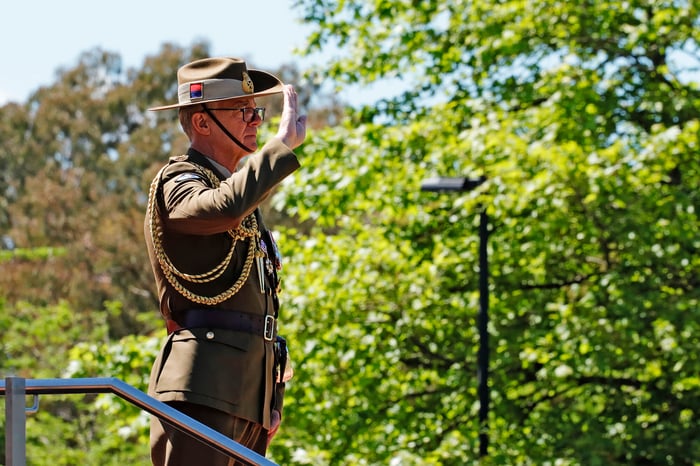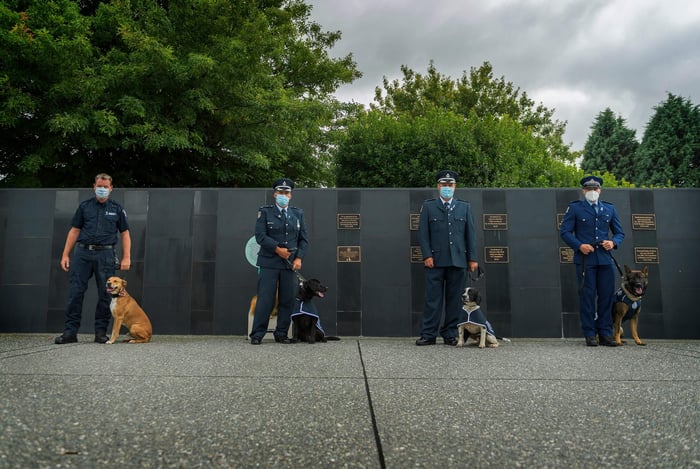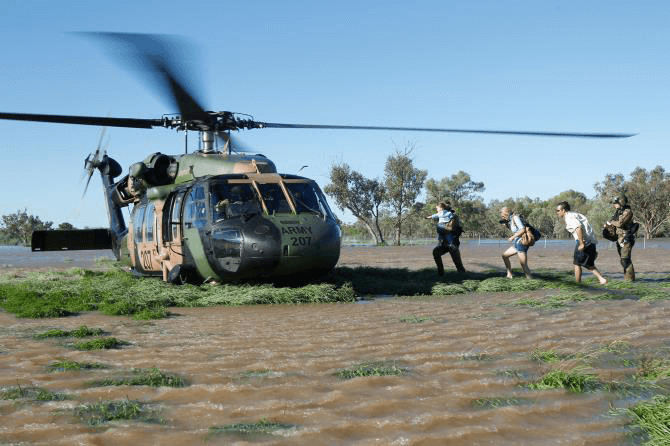
Farewell Good and Faithful Servant
On the 11th of December 2021 the Australian Army formally ceased operation of the Black Hawk helicopter, first introduced into the RAAF in 1988, and many, many pilots, loadmasters, engineers and maintainers will have found memories outstanding aircraft.
In 1984 the RAAF issued a tender to replace the aging UH-1s in Numbers 5 and 9 Squadrons. Those responding to the tender were Aerospatiale with the Super Puma, Westland with the w30-400, Bell proposed the (still in development) JVX tiltrotor, Sikorsky the S-70 (UH-60) and Augusta, a development of the Mongoose. The contenders were reduced to a short list of the Super Puma and the Black Hawk with the latter emerging as the preferred candidate. An initial order of 14 S70-A-9 was placed on the 29th of May 1986.
Fate intervened later that year when the Chiefs of Staff Committee decided that the battlefield helicopter fleet, exempt the Chinook, was to be transferred to Army ownership. Given the timing of the decision it was decided that the RAAF would introduce the first 14 Black Hawks into service before handing them over to the Army. In the meantime, Army was to raise a second regiment, the 5th, to provide the Army command and control capability.
The Airforce had already agreed to 9 Squadron moving to Townsville to better support the Operational Deployment Force based on the 3rd Brigade, and thus the 5th Aviation Regiment would take over the facilities being built on RAAF Townsville.
In May 1987 a further 25 Black Hawks were ordered, so that the combined total fleet would be able to lift the fighting elements of a rifle company and a share of support company assets and Black Hawk gunships would provide some attendant fire support.
The 5th Aviation Regiment was raised on to the Army Order of Battle on 20 November 1987 and Private Tony Steer, then a storeman at 162 Recce Squadron, was posted into the unit. He was then promoted LCpl. On 18 January 1988 thirteen others joined LCpl Steer as the skeleton headquarters of the Regiment was formed on RAAF Townsville.
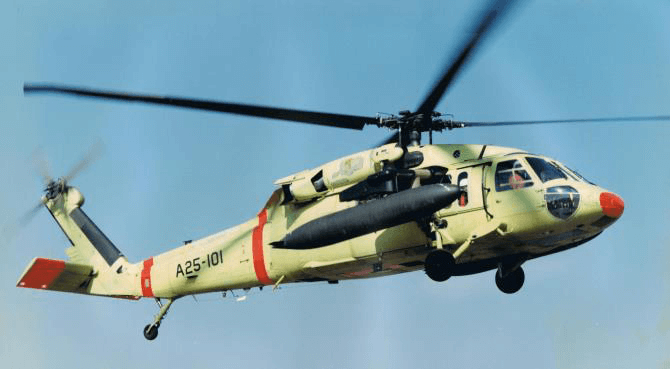
The first RAAF Black Hawk, A25-101, was handed over at the Sikorsky facility in Connecticut on 31 December 1987, a mere nineteen months after the order was placed! The aircraft was flown to Australia by RAAF C130 and delivered to 9 Squadron on 27th of February 1988.
The contract called for the rest of the first fourteen aircraft to be assembled at Bankstown by Hawker de Havilland, but initial production problems meant that only 7 were delivered in the first year. At the end of 1988, 9 Squadron relocated to Townsville and on 15th February 1989 the squadron was disbanded, and the aircraft transferred to Army ownership. 9 Squadron personnel, both RAAF and Army became A Squadron, 5 Avn Regt.
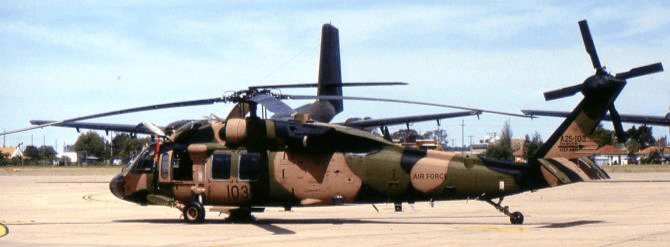
At the time of the transfers the Regiment hosted a number of RAN maintenance personnel as the delivery of Sea Hawks was behind schedule. They relished the opportunity to work on the Black Hawks. One of the jobs was to change ‘Air Force’ to ‘Army’ on the tailbooms of the aircraft. The temptation was too strong and it wasn’t long before three aircraft were paraded and photographed with ARMY, NAVY, and AIR FORCE clearly visible!
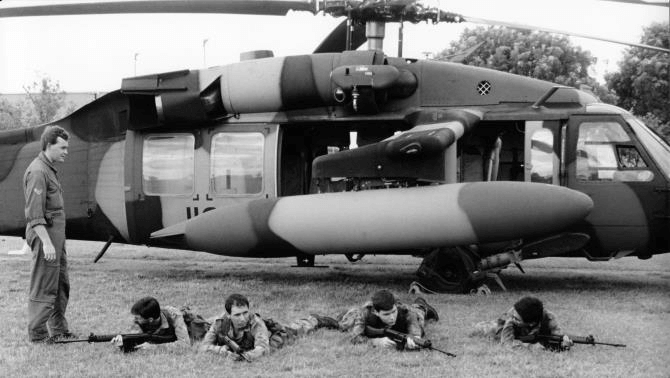
The steps from Kiowa to Black Hawk, one engine to two, and reconnaissance to air mobility were definitely a challenge for Army, but the solid support of the 9 Squadron personnel in the Regiment, led by (then) Wing Commander Angus Houston, helped immeasurably. Indeed by the middle of the year the Regiment was providing airmobile training for the two infantry battalions at the local training area. By August, A Squadron deployed on Exercise Kangaroo 89, along with a US Army Black Hawk company from Hawaii, and acquitted itself admirably.
The following year B Squadron was formed and, as a result of the decision not to pursue the arming of the Black Hawk with rockets and mini-guns, the Iroquois gunships were retained in service and transferred to 5 Avn Regt. A Squadron took on the counter-terrorism role from 5 Squadron RAAF, and the Regiment was involved in several aid to the civil community tasks including the longest overwater rescue at that time to pick up a crew dismasted in a severe storm off Rockhampton. Flooding in south western Queensland saw the Black Hawks join Iroquois in numerous rescues, and a major aircraft accident in north Queensland was the scene of extraordinary airmanship where the pilot and his crew hovered the Black Hawk backwards up the hill to the accident site in very marginal visibility conditions.
Deliveries of Australian assembled Black Hawks continued to improve to the point that the last aircraft A25-225 was accepted by the Army on 31st January 1991, five months ahead of schedule.
From this beginning the Army’s Black Hawk capability has grown and matured. The School of Army Aviation took on conversion and operational training in 1991. In 1992, in a spectacular display in Townsville, the Regiment conducted a company group lift, with 17 Black Hawks and a couple of Kiowa and Iroquois gunships which marked the achievement of full operational capability in just three years.

In 1993 a troop of six Black Hawks were deployed at short notice to Cambodia to provide support to Operation Gemini. The troop supported the electoral process in the country and were withdrawn after a short time. It was the first deployment overseas - many more were to come.
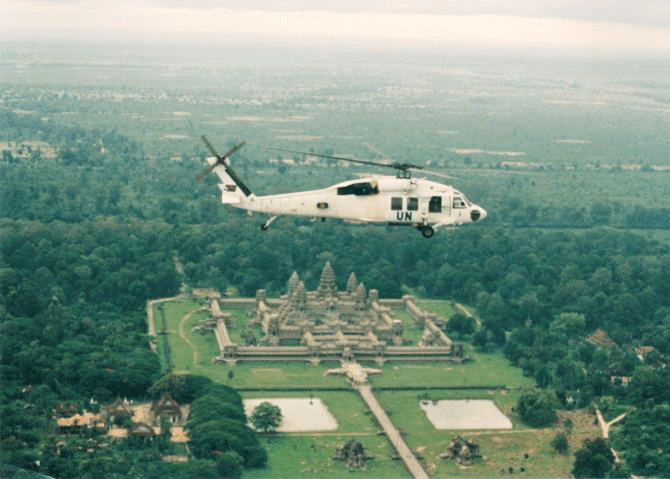
The following year saw five Black Hawks deployed to Bouganville in a peacekeeping operation, and again it was only a short deployment.
The Kangaroo 89 experience exposed the weakness of the absence of Chinooks (withdrawn from service by the RAAF in1989) and by 1994 staff work was well advanced for an innovative program to re-introduce Chinook, this time in Army service.
In 1994-95 Black Hawk availability plummeted and 5 Avn Regt was a sad place with aircraft lined up in the weather without engines, blades, gearboxes and other vital parts. This was caused by a dispute between the Army and the Air Force which caused insufficient funds to be available to repair components, once they were removed from the aircraft. It took the personal intervention of the Chief of the Air Force and the Chief of the Army on a visit to 5 Avn Regt to solve the problems and get the aircraft back in the air.
Around the same time as the repairable components were grounding aircraft, another problem was coming to light which would have a much longer term impact on the Australian Black Hawks. Army had always operated the aircraft in accordance with the flight envelope, but, as a survey was to reveal, not necessarily with respect to the usage spectrum. For example aircraft were operated with the external stores support system for a greater percentage of time than expected. Components on the Black Hawk were lifed according to the usage spectrum and consequently a number of components had their life reduced, some requiring considerable lead time for acquisition. This problem also contributed to the high rate of structural cracking that occurred in the Australian fleet compared to American aircraft. This structural cracking dogged the fleet for many years and significantly impacted availability in subsequent years.
There were also questions regarding the command and management of Army Aviation (at one stage 5 Avn Regt grounded their Black Hawks for a problem that the School of Army Aviation was happy to continue flying theirs!) and of the support provided by the RAAF under the Single Service Logistic Management arrangements.
A joint Army/Airforce team was set up in the second half of 1995 to examine the problems and the result was the establishment of Headquarters Aviation Support Group, led by a Brigadier, who had the responsibility and authority to manage the maintenance and operational airworthiness of Army Aviation. The Headquarters, with the help of Sikorsky, set about bolstering maintenance personnel by the addition of contractors, improving the flow of repair parts, and reducing cannibalisation. Slowly the Black Hawk availability showed signs of recovery.
In April 1996, in a superb demonstration of Black Hawk’s robustness, an aircraft carrying the then Prime Minister suffered main and tail rotor tree strikes while landing in a wooded area in north Queensland. Despite the severity of the strikes the helicopter continued to be controllable and the crew were able to safely land half a mile away from the incident. The main spar of one of the tail rotors was fractured, however, the pilot reported no vibration in the pedals, and he retained full directional authority. Following maintenance inspection the main rotors remained on the aircraft. The Black Hawk was built strong!
By the middle of 1996 clear improvements in Black Hawk availability were evident, and then on the 12th of June two Black Hawks collided in Townsville with the loss of 18 lives. It was a traumatic period for all, and the press even questioned the suitability of the Black Hawk for the job. It was established early in the investigation that mechanical failure had not played any part in the accident, and Black Hawk operations continued.
Availability steadily improved and in November 1997 three Black Hawks were deployed overseas again, this time to provide aid to the population of Papua New Guinea who were suffering from the effects of a serious drought. As the aircraft were withdrawn from PNG in April 1998, three more Black Hawks were deployed to (then) Irian Jaya, again to deliver food and supplies. They returned to Australia in July.
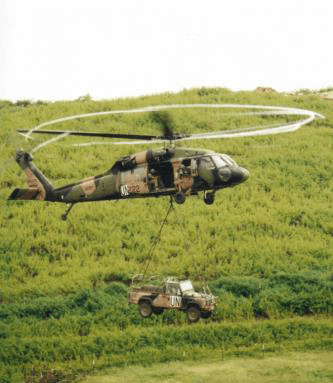 A little over a year later, unrest in East Timor saw Black Hawks again deploy, this time as part of the INTERFET force lead by Australia. This commitment would last into the second decade of the millennium.
A little over a year later, unrest in East Timor saw Black Hawks again deploy, this time as part of the INTERFET force lead by Australia. This commitment would last into the second decade of the millennium.
In 2004 a decision was taken to remove the counter terrorist capability from 5Avn Regt and place it directly under command of (then) 16 Brigade (Aviation). A Squadron was renamed 171 Aviation Squadron and 171 Operational Support Squadron, then in 1 Avn Regt, became A Squadron of 5 Avn Regt. Both squadrons remained in location: Townsville and Oakey respectively.
A major earthquake in Pakistan in October 2005 claimed the lives of 73,000 people and a medical contingent supported by four Black Hawks were quickly deployed. Australia’s contribution to the humanitarian relief operation was to last five months. The Black Hawks lifted over 2500 passengers, 181 tons of food, 68 tons of general cargo and more than 100 VIPs.
The following year a detachment of 171 Aviation Squadron was embarked on HMAS Kanimbla and deployed to waters off Fiji when unrest in the country lead to the possible need for the evacuation of Australian citizens. In the event the aircraft were not required, but unfortunately one of the Black Hawks crashed on the flight deck of the ship and was lost overboard. Sadly, the aircraft captain and one of the SAS troopers were lost in the accident.
 In 2007 the 6th Aviation Regiment was raised onto the Order of Battle and 171 Aviation Squadron and 173 Surveillance Squadron (fixed wing) were placed under command. In time the Army’s fixed wing capability was transferred to the RAAF, and the Regiment focussed on counter terrorism and support to Special Forces.
In 2007 the 6th Aviation Regiment was raised onto the Order of Battle and 171 Aviation Squadron and 173 Surveillance Squadron (fixed wing) were placed under command. In time the Army’s fixed wing capability was transferred to the RAAF, and the Regiment focussed on counter terrorism and support to Special Forces.
In 2009 two Black Hawks were deployed by RAAF C-17 to PNG to provide support following a Twin Otter accident near Kokoda. The aircraft were in PNG by mid-afternoon of the same day and at the site shortly after.
Interspaced between, and often overlapping, this travelogue of activity are the countless times Black Hawks have been called on to provide support to the civil community in times of distress. Floods, bushfires, cyclones, searches, rescues, even the delivery of footballs, you name it, Black Hawk has been involved.
The delays in delivery of the MRH90 and its problematic serviceability and supportablilty has resulted in the gradual extension of the withdrawal date for Black Hawk. For an aircraft that was expecting to undergo a mid-life upgrade at around the turn of the century, the Black Hawk has just kept on keeping on much like a well-known battery. In a ceremony at the parade to mark the 50th anniversary of the formation of the Australian Army Aviation Corps, Sikorsky presented the Chief of Army a certificate marking more than 200,000 flying hours in Army colours.
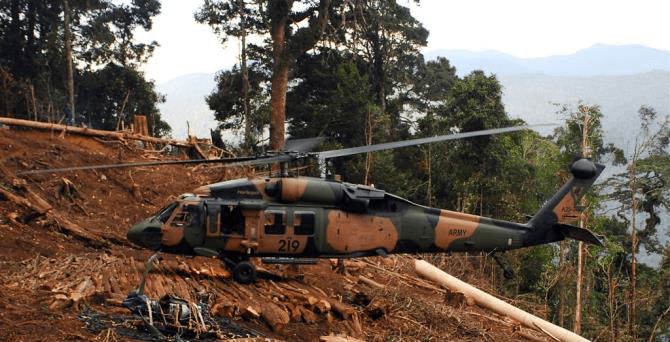
Of course, it has not always been smooth sailing. Sadly 21 servicemen, including five aircrew have been killed in Black Hawks in three major accidents and five aircraft have been written off. In addition to the lifing problem with repairable items, availability has been affected by corrosion and cracking of the fuselage.
When the Black Hawk was introduced into service and transferred to Army, it did so as a battlefield helicopter. It’s ironic that of all the deployments across the world in 33 years and 200,000 hours, none was on a battlefield.
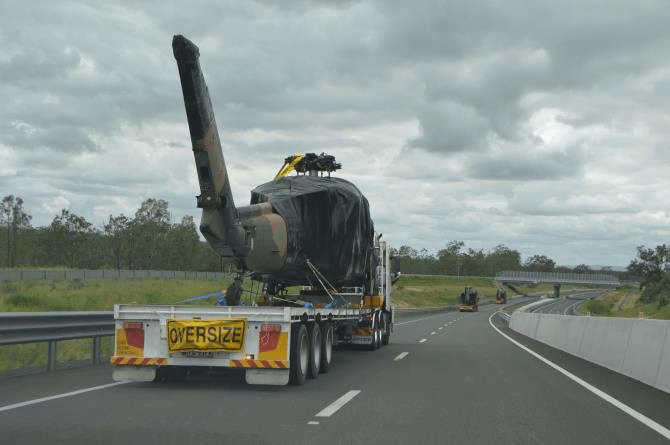
(*Originally written by Bill Mellor, with Jock Crocombe and Peter Simpsonfor Air Mail, the newsletter of the Australian Army Aviation Association. Shared with permission)






